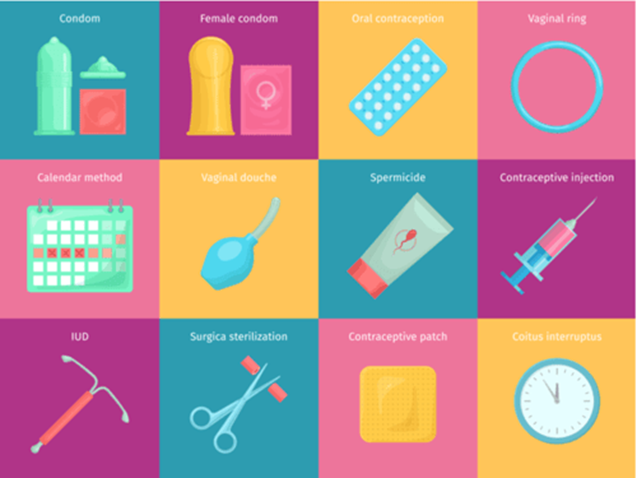Culture | Relationship | Diversity | Body | Skills | Experience | Safety
Introduction
In the intricate tapestry of adolescence, the exploration of sexuality stands as a pivotal thread. Acknowledging and addressing the nuances of sexual health in young people is not just a matter of biological awareness but a crucial step towards fostering a generation that is informed, empowered, and resilient. As youth workers, educators, and activists we play a pivotal role in guiding these explorations, providing a compass for understanding, and creating spaces where questions can be asked without judgment.
The journey through sexuality is more than a biological phenomenon; it is a multifaceted exploration of identity, desire, and relationships. In this chapter, we will delve into the landscape of youth sexuality, recognizing its complexity and the challenges it presents. Our aim is not only to equip youth workers with knowledge but to empower them with the tools needed to facilitate open and supportive conversations.
Understanding Sexuality and Life Cycles
Defining Sexuality: A Spectrum of Identity
The realm of first sexual experiences among young individuals is a terrain of exploration, self-discovery, and complex emotions, and therefore oftentimes a tumultuous journey. As youth workers it is our duty and calling, above all, to foster a supportive environment that promotes healthy sexual development, responsible decision-making, and informed choices.
Sexuality is not a fixed point but rather a dynamic and individualized spectrum of identity. It is a complex and multifaceted aspect of human identity and experience that encompasses a range of physical, emotional, romantic, and social dimensions. It refers to an individual’s sexual orientation, attractions, behaviours, and how they relate to their own gender identity and the gender(s) to which they are attracted. Sexuality can encompass various components, and is widely influenced by cultural, social, and historical factors.
Although it is challenging to provide an exhaustive list of the biggest problems and issues young people throughout Europe are currently facing in regard to their sexuality and their first sexual explorations, common issues include lack of comprehensive and inclusive sex education, peer pressure and expectations, online challenges, sexual violence and harassment, consent education, body image issues, insufficient knowledge about the emotional components of the menstrual cycle, stigma and discrimination, coming out challenges and family rejection, cultural and religious influences, and mental health, to name but a few.
When engaging with young people, it is crucial to create a space where everyone feels safe and accepted. We want them to understand that their sexuality is a unique part of who they are, influenced by experiences and self-discovery. It is also important to talk about how different cultures and societies have varying views on sexuality, helping them recognize where their beliefs come from. Sexuality is personal and can be shaped by family, culture, and religion, but it is also something that can evolve over time. By discussing these aspects openly, we aim to empower young individuals to navigate their sexual identity with awareness and respect for diversity, recognizing that everyone’s journey is different.
Life Cycles: Navigating the Phases of Sexual Development
As youth workers, understanding the diverse stages of sexual development is key to providing effective support. Adolescence marks the onset of this journey, bringing about physical changes, emotional awakening, and the exploration of relationships. Transitioning into adulthood involves further self-discovery and the establishment of a more nuanced understanding of one’s sexual identity. Navigating these phases requires patience, empathy, and a recognition of the varied paths individuals may take.

Image taken from: LINK
See also: teentalk.ca: LINK
Our role as youth workers is not merely that of observers; we are guides through these transformative stages. Creating an environment that encourages questions, respects diverse experiences, and fosters self-acceptance is essential.
So, how to do this?
To foster an understanding of sexuality as a spectrum, we can practice the following techniques:
Use of Inclusive Language: Use inclusive and non-binary language when discussing sexuality. This creates an environment where individuals feel acknowledged regardless of where they fall on the spectrum.
Sharing Personal Experience: Share personal stories or anecdotes that highlight the diversity of sexual experiences. Real-life narratives can humanize the concept of sexuality and make it more relatable.
Interactive Workshops: Organize interactive workshops that encourage self-reflection. Activities such as journaling or group discussions can help young people explore and express their evolving feelings about their own sexuality.
Educational Workshops: Conduct age-appropriate workshops that address the physical and emotional changes during adolescence. Offer information on topics such as puberty, relationships, and consent.
Peer Support Groups: Establish peer support groups where young individuals can share their experiences and concerns. This creates a sense of community and allows for the exchange of insights among peers.
One-on-One Sessions: Provide confidential one-on-one sessions for those who may prefer a more private setting. This allows for personalized guidance tailored to an individual’s unique needs and questions.
To actively contribute to these goals, it is essential to cultivate open communication, creating a space where youth feel free to discuss their questions and concerns without judgment. Providing training sessions for youth workers enhances their knowledge of diverse sexual identities, enabling them to offer informed and sensitive support. Additionally, sharing curated resources, including books, articles, and websites, that offer accurate and inclusive information empowers young individuals to explore further on their own.
Pleasure, Desire, and Consent
While navigating sexual pleasure, desire, and consent, young people of all ages encounter multifaceted challenges. Some individuals have researched on their own, mostly through online content, supportive websites, podcasts, and educational social media channels, and seem well educated on these topics. Unfortunately, for a highly significant amount of young people the impact of inadequate or inconsistent sex education remains a prevailing concern, since they seem ill-equipped to understand and communicate their desires, boundaries, and the importance of consent.
Societal expectations, fueled by digital media and peer pressure, can influence the ways in which young people explore their sexualities, potentially leading to experiences that are not fully consensual or satisfying. A special emphasis here is on girls and young women, who are mostly raised to be pleasing and to prioritize other people’s desires before their own, while boys and young men are mostly conditioned into repressing their emotions and vulnerability. Additionally, the stigma surrounding diverse sexual orientations and identities may hinder open discussions, inhibiting the development of healthy attitudes towards pleasure and desire. The issue of consent is central, with variations in awareness and understanding across cultures and communities. Encouraging comprehensive, inclusive sex education, fostering open dialogues, and challenging societal norms that perpetuate harmful stereotypes are essential steps towards creating an environment where young people can navigate their sexual experiences with confidence, respect, and a genuine understanding of consent.

Image taken from: LINK
See also: lovetolove.com: LINK
In the realm of sexual exploration, it is imperative for youth workers to guide young individuals through the natural aspects of human sexuality. Initiating open conversations on pleasure and desire, we break down societal taboos, emphasizing that these experiences are normal facets of human growth. By debunking myths and stereotypes, we foster a positive and realistic view of sexual experiences, encouraging self-exploration without shame.
The crucial role of the youth worker in this regard is to provide resources that focus on healthy relationships, communication, and the importance of mutual respect. Through these efforts, we contribute to the development of informed and empowered individuals capable of navigating the complexities of their sexual experiences.
What to do? You can invite the young people to participate in the following:
Interactive Workshops on Consent: Conduct workshops that illustrate the concept of consent through scenarios and role-playing exercises. This allows young people to understand the practical aspects of asking for and giving consent. Communication skills training equips young individuals to express their boundaries and desires confidently, ensuring mutual understanding.
Communication Skills Training: Equip young individuals with effective communication skills to express their boundaries and desires clearly. This empowers them to navigate relationships with confidence and ensures mutual understanding. Moreover, we address the impact of peer pressure on decisions related to pleasure and desire. Empowering young individuals to make choices aligned with their values, we shape healthy perspectives on relationships.
Understanding Non-Verbal Cues: Highlight the significance of recognizing non-verbal cues and body language as part of the consent dialogue. Stress the importance of continuous communication and the ability to withdraw consent at any point.
Preventing Unwanted Pregnancy and Sexually Transmitted Diseases
Exploring the landscape of sexual health together with young people involves equipping them with the knowledge and tools to make informed decisions. When discussing safe sex practices, include discussions on various methods of contraception and provide information on the effectiveness and accessibility of contraceptives, ensuring that young individuals are aware of the options available to them.

Image taken from: LINK
Simultaneously, addressing sexually transmitted infections (STIs) is paramount. Instead of merely presenting facts, a comprehensive approach involves discussing common STIs and emphasizing prevention strategies. By exploring the importance of regular testing, open communication with partners, and the use of protective measures, youth workers contribute to building a foundation of sexual health awareness.
How to do this? In the realm of preventing unwanted pregnancies and STIs, youth workers can employ various methods to impart crucial knowledge.
Engaging Activities and Conversations: Rather than providing a list of contraceptives, initiate engaging conversations about safe sex practices or use engaging games or activities. Make it fun! Discuss the importance of using protection, the variety of contraceptive methods available, and their respective pros and cons. Approach the topic with sensitivity, acknowledging that each individual’s needs may differ.
Real-World Scenarios: Illustrate the practical application of safe sex practices through real-world scenarios. By presenting relatable situations, youth workers can demonstrate the impact of responsible decision-making and the potential consequences of unprotected sex, fostering a deeper understanding among young people.
Interactive Workshops: Conduct interactive workshops that allow young individuals to explore and understand contraceptive methods hands-on. Utilize visual aids, guest speakers, or even demonstrations to enhance the learning experience. This approach can make the information more accessible and memorable.
Community Resources: Connect young people with community resources that provide information on sexual health. This can include local clinics, online platforms, or informational pamphlets. By encouraging them to explore these resources, youth workers empower young individuals to take charge of their sexual health.
Abortion and Decision-Making
Abortion is a highly sensitive and nuanced topic that demands a balanced overview, acknowledging its complexity and the personal nature of the decision-making process. Youth workers can play a crucial role in providing young people with a comprehensive understanding of abortion, emphasizing the importance of informed decision-making. prevention is crucial and information helps a lot! By fostering an environment that encourages questions and dispels myths, contribute to creating a space where individuals can explore their feelings and beliefs surrounding abortion without judgment.
Keeping in mind that youth workers are not doctors or health professionals, in difficult decisions like abortion, their role extends beyond information provision. They become pillars of emotional support, guiding young individuals through the challenges associated with this decision. By discussing support systems, youth workers emphasize the importance of seeking emotional support from friends, family, and professionals. Recognizing the emotional impact of such decisions, youth workers become advocates for the mental well-being of young people, ensuring they are not alone in navigating these complex and sensitive choices.

Image taken from: LINK
See also: San Diego Youth Service: LINK
What to do? Addressing abortion and decision-making requires a thoughtful and supportive approach:
Open Forums for Discussion: Create open forums where young individuals can openly discuss abortion without fear of judgment. These discussions can involve guest speakers, personal narratives, or expert panels to present a diverse range of perspectives and experiences.
Case Studies: Utilize case studies to present realistic scenarios involving abortion decisions. This method allows youth workers to guide discussions around the complexities individuals might face, encouraging critical thinking and empathy among young people.
Role-Playing Exercises: Engage in role-playing exercises that simulate the decision-making process surrounding abortion. This interactive approach allows young individuals to explore their emotions, values, and beliefs in a safe and controlled environment.
Community Resources: Youth workers can help individuals explore their feelings, provide information, and connect them with additional resources as needed. Connect young people with community resources and counseling services that provide information on the topic. This can include local clinics, online platforms, or informational pamphlets. By encouraging them to explore these resources, you can empower young individuals to take charge of their sexual health.
By implementing these methods, youth workers can create an environment that not only imparts information but also encourages open dialogue, critical thinking, and emotional support around the sensitive topics of preventing unwanted pregnancies, STIs, and abortion decisions.
Supporting Young People
In the vital role of supporting young people, youth workers serve as guiding lights through the intricate terrain of sexuality. Creating spaces that are open and non-judgmental, they encourage free expression of thoughts, concerns, and questions about sex and relationships. By building environments grounded in trust, youth workers facilitate meaningful conversations that contribute to the overall well-being of the young minds they guide.
Combatting societal stigma around sexuality is a crucial aspect of support. Engaging in conversations that challenge stereotypes, youth workers promote a more inclusive understanding of diverse sexual experiences. By addressing stigma head-on, these advocates contribute to cultivating empathy, respect, and acceptance within the communities they serve.

Image taken from: LINK
See also: Center for Disease Control and Prevention : LINK
Equipping young people with necessary resources is integral to support. Youth workers play a vital role in providing information on available resources and support services related to sexual health and emotional well-being. By connecting individuals with external assistance, whether it be clinics, helplines, or counseling services, youth workers ensure that young people have access to the comprehensive support they need on their journey of self-discovery.
In weaving these threads of open dialogues, stigma dismantling, and resource provision, youth workers fortify their commitment to nurturing the holistic development of young individuals as they navigate the multifaceted aspects of sexuality and relationships. Through these concerted efforts, they empower the youth to emerge resilient, informed, and capable of shaping healthy and fulfilling futures.
Conclusion
As we conclude this chapter, we underscore the significance of youth workers in shaping the narrative of young people’s sexual journeys. In the pivotal role of supporting young people, youth workers serve as beacons of guidance through the intricate terrain of sexuality.
Standing as guardians of open dialogues, addressing stigma, and providing vital resources, youth workers foster understanding, empathy, and acceptance, creating environments where young individuals can confidently navigate the complexities of their sexuality. To tackle challenges effectively, a comprehensive approach involving improved sex education, destigmatization of diverse sexual orientations, accessible healthcare services, and efforts to promote healthy relationships is essential. Policymakers, educators, communities, and LGBTQ+ support organizations all play crucial roles in creating an inclusive and affirming environment. In this comprehensive guide, youth workers are called to be not just educators but compassionate guides, empowering the youth to make informed choices and fostering a future where sexual well-being is embraced without judgment. In their crucial role, youth workers contribute to the collective endeavour of nurturing resilient, informed, and empowered individuals prepared to embark on a journey of self-discovery and healthy relationships.
And remember; since the topics of sexuality are more often than not connected to the feelings of shame, remember to make it fun and playful.
References
- Planned Parenthood: LINK
- Scarleteen: Sex ed for the real world: LINK
- Advocates for youth: Our bodies. Our Lives. Our Movement: LINK
- Sex Education Forum: The voice for relationships and sex education: LINK
Culture | Relationship | Diversity | Body | Skills | Experience | Safety
